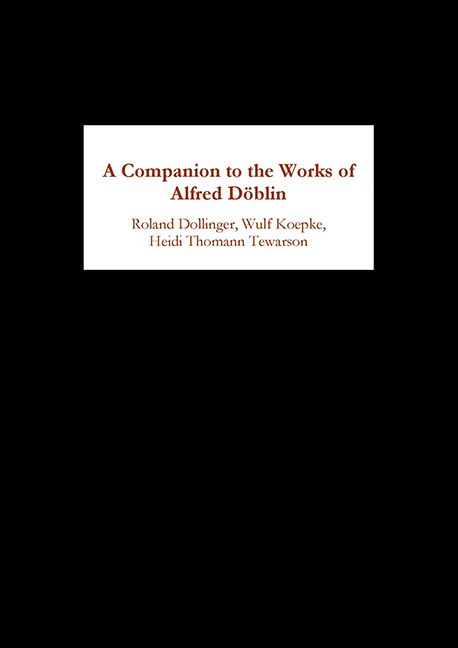Book contents
- Frontmatter
- Contents
- Foreword
- Abbreviations and Translations of Titles
- Works by Alfred Döblin
- Introduction
- Early Works
- Döblin's Early Collection of Stories, Die Ermordung einer Butterblume: Toward a Modernist Aesthetic
- The Advent of Döblinism: Die drei Sprünge des Wang-lun and Wadzeks Kampf mit der Dampfturbine
- Works of the Weimar Period
- Exile and Return to Europe
- Bibliography
- Notes on the Contributors
- Index
Döblin's Early Collection of Stories, Die Ermordung einer Butterblume: Toward a Modernist Aesthetic
from Early Works
Published online by Cambridge University Press: 27 April 2017
- Frontmatter
- Contents
- Foreword
- Abbreviations and Translations of Titles
- Works by Alfred Döblin
- Introduction
- Early Works
- Döblin's Early Collection of Stories, Die Ermordung einer Butterblume: Toward a Modernist Aesthetic
- The Advent of Döblinism: Die drei Sprünge des Wang-lun and Wadzeks Kampf mit der Dampfturbine
- Works of the Weimar Period
- Exile and Return to Europe
- Bibliography
- Notes on the Contributors
- Index
Summary
When Alfred Döblin died in 1957 at the age of seventy-nine, he was all but unknown. His books, confiscated and burned by the Nazis, had not been reissued, and the novels written in exile had found little or no response in postwar Germany. Only the monumental historical novel, November 1918. Eine deutsche Revolution, nearly finished at the time of Döblin's return to Europe in 1945, was published in a truncated edition in Munich between 1948 and 1950. His last novel, Hamlet oder die lange Nacht nimmt ein Ende, on the other hand, written in 1945, did not find a publisher until 1956.
But at the beginning of the century, Döblin was considered one of the foremost avant-garde writers. Bertolt Brecht (1898–1956) considered him a great prose writer and one of his “two illegitimate fathers” (the other was the playwright Georg Kaiser [1878–1945]) (Sternberg 16). Contemporary writers of quite opposing artistic orientations, such as the expressionist Kasimir Edschmid (pseud. Eduard Schmid, 1890–1966) and the more matter-of-fact novelist Lion Feuchtwanger (1884–1958), also saw Döblin as “ein hervorragend bedeutender Autor,” who portrays a “völlig neue Welt” and writes in a language of “meisterhaften Gegenständlichkeit.” “Nirgendwo jener Naturalismus, der das Resultat von Studien, mit einiger Psychologie vermengt, wiedergibt” (Schuster/Bode 25, 29, 50). The usually skeptical novelist Robert Musil (1880–1942), in a lengthy review of Döblin's Indian epos, Manas: Epische Dichtung (1926), predicted that this work would become very influential (Schuster/Bode 192). And in 1929, the eminent critic Herbert Ihering suggested that Döblin was really the only German candidate for the Nobel prize in literature (Ihering 446–47).
Because Döblin began to publish in 1910, he is often labeled an Expressionist. In part, this was also due to his association with Herwarth Walden (1878–1941) and his literary magazine, Der Sturm. A cofounder, he published most of his early works there, and mingled with many of the other contributors and members belonging to Walden's bohemian circle. His literary beginnings, however, also show many thematic and stylistic affinities with his contemporaries, Hugo von Hofmannsthal (1874–1929), Carl Sternheim (1878–1942), and Thomas Mann (1875–1955). Thus, Döblin's search for a new aesthetic dates back to the turn of the century and emanated from the kinds of problems faced also by this earlier generation.
- Type
- Chapter
- Information
- A Companion to the Works of Alfred Döblin , pp. 23 - 54Publisher: Boydell & BrewerPrint publication year: 2003



